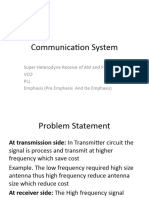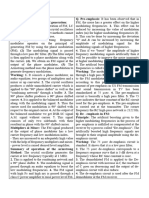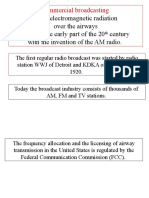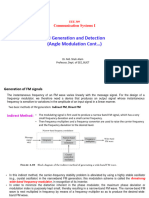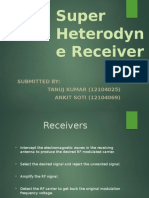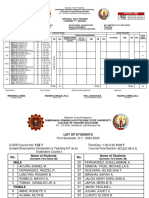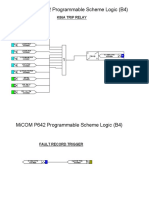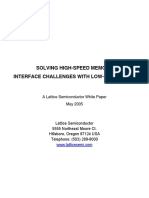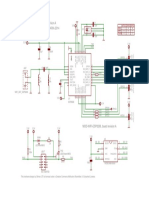Week 10 FM Radio 1.10 ELEX 221
Week 10 FM Radio 1.10 ELEX 221
Uploaded by
France PilapilCopyright:
Available Formats
Week 10 FM Radio 1.10 ELEX 221
Week 10 FM Radio 1.10 ELEX 221
Uploaded by
France PilapilOriginal Title
Copyright
Available Formats
Share this document
Did you find this document useful?
Is this content inappropriate?
Copyright:
Available Formats
Week 10 FM Radio 1.10 ELEX 221
Week 10 FM Radio 1.10 ELEX 221
Uploaded by
France PilapilCopyright:
Available Formats
Week 10
FM RADIO 1.10 ELEX 221
Frequency division multiplexing is used in radio and television receivers. The main
use of FM is for radio communications. Let us take a look at the structure of FM
transmitter and FM receiver along with their block diagrams and working.
a. FM Transmitter
FM transmitter is the whole unit which takes the audio signal as an input and delivers
FM modulated waves to the antenna as an output to be transmitted. FM transmitter
consists of 6 main stages. They are illustrated in the following figure.
The working of FM transmitter can be explained as follows.
The audio signal from the output of the microphone is given to the pre-amplifier
which boosts the level of the modulating signal.
This signal is then passed to the high pass filter, which acts as a pre-emphasis
network to filter out the noise and improve the signal to noise ratio.
This signal is further passed to the FM modulator circuit.
The oscillator circuit generates a high frequency carrier, which is given to the
modulator along with the modulating signal.
Several stages of frequency multiplier are used to increase the operating
frequency. Even then, the power of the signal is not enough to transmit. Hence,
a RF power amplifier is used at the end to increase the power of the modulated
signal. This FM modulated output is finally passed to the antenna to get
transmitted.
b. Requirements of a Receiver
A radio receiver is used to receive both AM band and FM band signals. The detection
of AM is done by the method called as Envelope Detection and the detection of FM is
done by the method called as Frequency Discrimination.
Such a radio receiver has the following requirements.
It should be cost effective.
BTVTED ELEX 221 1 | P a g e rey.lacandalo@gmail.com
BROADBAND Unit: 2 Lec: 1 Lab: 3
It should receive both AM and FM signals.
The receiver should be able to tune and amplify the desired station.
It should have an ability to reject the unwanted stations.
Demodulation has to be done to all the station signals, whatever the carrier
frequency is.
For these requirements to get fulfilled, the tuner circuit and the mixer circuit should
be very effective. The procedure of RF mixing is an interesting phenomenon.
c. RF Mixing
The RF mixing unit develops an Intermediate Frequency (IF) to which any received
signal is converted, so as to process the signal effectively.
RF Mixer is an important stage in the receiver. Two signals of different frequencies
are taken where one signal level affects the level of the other signal, to produce the
resultant mixed output. The input signals and the resultant mixer output is illustrated
in the following figures.
BTVTED ELEX 221 2 | P a g e rey.lacandalo@gmail.com
BROADBAND Unit: 2 Lec: 1 Lab: 3
When two signals enter the RF mixer,
The first signal frequency = F1
The second signal frequency = F2
Then, the resultant signal frequencies = (F1 + F2) and (F1 - F2)
A mixer of two signals of different frequencies are produced at the output.
If this is observed in frequency domain, the pattern looks like the following figure.
The symbol of a RF mixer looks like the following figure.
BTVTED ELEX 221 3 | P a g e rey.lacandalo@gmail.com
BROADBAND Unit: 2 Lec: 1 Lab: 3
The two signals are mixed to produce a resultant signal, where the effect of one
signal, affects the other signal and both produce a different pattern as seen
previously.
d. FM Receiver
The FM receiver is the whole unit which takes the modulated signal as input and
produces the original audio signal as an output. Radio amateurs are the initial radio
receivers. However, they have drawbacks such as poor sensitivity and selectivity.
Selectivity is the selection of a particular signal while rejecting the
others. Sensitivity is the capacity of detecting a RF signal and demodulating it, while
at the lowest power level.
To overcome these drawbacks, super heterodyne receiver was invented. This FM
receiver consists of 5 main stages. They are as shown in the following figure.
A superheterodyne receiver, often shortened to superhet, is a type of radio
receiver that uses frequency mixing to convert a received signal to a
fixed intermediate frequency (IF) which can be more conveniently processed than the
original carrier frequency. It was long believed to be invented by US engineer Edwin
Armstrong, but after some controversy the patent is now credited to French radio
engineer and radio manufacturer Lucien Lèvy. Virtually all modern radio receivers use
the superheterodyne principle.
e. RF Tuner Section
The modulated signal received by the antenna is first passed to the tuner
circuit through a transformer. The tuner circuit is nothing but a LC circuit, which is
also called as resonant or tank circuit. It selects the frequency, desired by the radio
receiver. It also tunes the local oscillator and the RF filter at the same time.
f. RF Mixer
The signal from the tuner output is given to the RF-IF converter, which acts as a
mixer. It has a local oscillator, which produces a constant frequency. The mixing
process is done here, having the received signal as one input and the local oscillator
frequency as the other input. The resultant output is a mixture of two frequencies [(f1 +
f2),(f1 − f2)] produced by the mixer, which is called as the Intermediate Frequency (IF).
BTVTED ELEX 221 4 | P a g e rey.lacandalo@gmail.com
BROADBAND Unit: 2 Lec: 1 Lab: 3
The production of IF helps in the demodulation of any station signal having any carrier
frequency. Hence, all signals are translated to a fixed carrier frequency for adequate
selectivity.
g. IF Filter
Intermediate frequency filter is a bandpass filter, which passes the desired frequency.
It eliminates any unwanted higher frequency components present in it as well as the
noise. IF filter helps in improving the Signal to Noise Ratio (SNR).
h. Demodulator
The received modulated signal is now demodulated with the same process used at
the transmitter side. The frequency discrimination is generally used for FM detection.
i. Audio Amplifier
This is the power amplifier stage which is used to amplify the detected audio signal.
The processed signal is given strength to be effective. This signal is passed on to the
loudspeaker to get the original sound signal.
This super heterodyne receiver is well used because of its advantages such as better
SNR, sensitivity and selectivity.
j. Noise in FM
The presence of noise is a problem in FM as well. Whenever a strong interference
signal with closer frequency to the desired signal arrives, the receiver locks that
interference signal. Such a phenomenon is called as the Capture effect.
To increase the SNR at higher modulation frequencies, a high pass circuit
called preemphasis, is used at the transmitter. Another circuit called de-emphasis,
the inverse process of pre-emphasis is used at the receiver, which is a low pass
circuit. The preemphasis and de-emphasis circuits are widely used in FM transmitter
and receiver to effectively increase the output SNR.
BTVTED ELEX 221 5 | P a g e rey.lacandalo@gmail.com
BROADBAND Unit: 2 Lec: 1 Lab: 3
You might also like
- Analog Communication - Transmitters & Receiver by Arijit Manna (Midnapore City College, Post Graduate 1 Sem)Document7 pagesAnalog Communication - Transmitters & Receiver by Arijit Manna (Midnapore City College, Post Graduate 1 Sem)arijit mannaNo ratings yet
- Analog Communication - ReceiversDocument6 pagesAnalog Communication - ReceiverscdrupwestNo ratings yet
- Ee-304 Communication Systems Project Report Section-C: Engr. Talha AsgharDocument9 pagesEe-304 Communication Systems Project Report Section-C: Engr. Talha AsgharMohammad WastiNo ratings yet
- Quarter 3 - Module 3 Radio Receiver CircuitDocument3 pagesQuarter 3 - Module 3 Radio Receiver CircuitMychelle HidalgoNo ratings yet
- Updated - 2022 - Radio ReceiverDocument9 pagesUpdated - 2022 - Radio ReceiverHemed hafidhNo ratings yet
- Radio Transmission: AM TransmitterDocument3 pagesRadio Transmission: AM TransmitterPatro GoodfridayNo ratings yet
- Super Heterodyne Receiver-A: ST NDDocument3 pagesSuper Heterodyne Receiver-A: ST NDEunice Jane Bolgado-DoctorNo ratings yet
- FM TransmitterDocument38 pagesFM TransmitterTushar Goel100% (1)
- Transmitters and ReceiversDocument63 pagesTransmitters and Receiversnct127.leemakmakNo ratings yet
- TP ReceiversDocument11 pagesTP ReceiversWest VougeNo ratings yet
- rohini_23644062494Document7 pagesrohini_23644062494ዳን ኤልNo ratings yet
- Document in Communication TheoryDocument7 pagesDocument in Communication TheoryPatrick Rain SantiagoNo ratings yet
- Q3 Wk3.1 Radio Receiver CircuitDocument53 pagesQ3 Wk3.1 Radio Receiver CircuitMikaela KayeNo ratings yet
- How To Build An FM Transmitter Circuit Its Working and ApplicationsDocument3 pagesHow To Build An FM Transmitter Circuit Its Working and ApplicationsFosterNo ratings yet
- Super Hyterodyne ReceiverDocument34 pagesSuper Hyterodyne ReceiverQaisar BalochNo ratings yet
- Superheterodyne Radio ReceiverDocument16 pagesSuperheterodyne Radio ReceiverTuanNo ratings yet
- Superheterodyne ReceiverDocument16 pagesSuperheterodyne ReceiverAmrit Raj100% (1)
- Principles of Electronic Communication Systems: Second EditionDocument56 pagesPrinciples of Electronic Communication Systems: Second EditionengaydiNo ratings yet
- Analog Commuunications-Unit-4Document12 pagesAnalog Commuunications-Unit-4v c sekhar gollaNo ratings yet
- Communication SystemsDocument16 pagesCommunication SystemsLakshmiNo ratings yet
- Mini FM Station - 1Document39 pagesMini FM Station - 1electronicsmadeeasy_emeNo ratings yet
- Pec Module Iv - Rev 21 2024-25-AkaDocument14 pagesPec Module Iv - Rev 21 2024-25-Akaadithyanmj3No ratings yet
- B.SC Electronics D2 P4 (2020) SolutionsDocument15 pagesB.SC Electronics D2 P4 (2020) SolutionsShubham KeshriNo ratings yet
- PCS 1 ReDocument16 pagesPCS 1 Residdheshawasare0000No ratings yet
- Commercial BroadcastingDocument22 pagesCommercial BroadcastingSuresh KumarNo ratings yet
- CS6 PreDocument8 pagesCS6 Preratomthalane12No ratings yet
- Experiment No: 01 Experiment Name: Study & Analysis of AM ReceiverDocument20 pagesExperiment No: 01 Experiment Name: Study & Analysis of AM ReceiverMehedi HasanNo ratings yet
- Superheterodyne ReceiverDocument5 pagesSuperheterodyne ReceiverShashi SumanNo ratings yet
- Amplitude Modulation (Part2)Document14 pagesAmplitude Modulation (Part2)Ryan Anthony AndalNo ratings yet
- AM ReceptionDocument32 pagesAM ReceptionepyhepyNo ratings yet
- Comm - Chapter 4 Radio ReceiverDocument12 pagesComm - Chapter 4 Radio ReceiverAbdi JoteNo ratings yet
- Module - 06 FM Transmitter and ReceiverDocument13 pagesModule - 06 FM Transmitter and ReceiverAmin Wahid100% (1)
- Ce Nov 19 R17Document18 pagesCe Nov 19 R17Anonymous yO7rcec6vuNo ratings yet
- ECE 421 Lab4Document39 pagesECE 421 Lab4LuelsonCordovaDeclaradorNo ratings yet
- Radio or FM Receiver Is An Electronic Device That Receives Radio Waves and Converts The Information Carried by Them To A Usable FormDocument3 pagesRadio or FM Receiver Is An Electronic Device That Receives Radio Waves and Converts The Information Carried by Them To A Usable FormzesleyNo ratings yet
- Communication PresentationDocument15 pagesCommunication Presentationhaldar22205131125No ratings yet
- 10 FM Generation DetectionDocument10 pages10 FM Generation DetectionLive MCQ ExamNo ratings yet
- AM ReceiverDocument8 pagesAM ReceiverSean Matthew L. OcampoNo ratings yet
- Superheterodyne RecieverDocument44 pagesSuperheterodyne RecieverTanuj Kumar100% (2)
- Module 1Document21 pagesModule 1albertnoyalktNo ratings yet
- Radio Principles Precis 2Document80 pagesRadio Principles Precis 2JOSPHAT YEGONNo ratings yet
- Unit 3: Radio ReceiverDocument54 pagesUnit 3: Radio ReceiverAK 1No ratings yet
- Chapter Four: Topics Discussed in This SectionDocument34 pagesChapter Four: Topics Discussed in This SectionSolomon Tadesse AthlawNo ratings yet
- Unit 3 Communication TheoryDocument33 pagesUnit 3 Communication Theoryjudehemanth100% (1)
- 4.8 FM Receivers: Limiter, Frequency DiscriminatorDocument8 pages4.8 FM Receivers: Limiter, Frequency DiscriminatorKhairil Azwan TugimanNo ratings yet
- Superheterodyne RecieverDocument33 pagesSuperheterodyne RecieverTanuj KumarNo ratings yet
- Cell: 9952749533 WWW - Researchprojects.info: ExpertsDocument16 pagesCell: 9952749533 WWW - Researchprojects.info: Expertssetsindia3735No ratings yet
- Electronics Quarter 3 HandoutDocument8 pagesElectronics Quarter 3 HandoutZachary BautistaNo ratings yet
- TV C 2 KeyDocument6 pagesTV C 2 KeyVanitha DNo ratings yet
- To Design and Implement An FM Receiver For A Desired Frequency Band 1Document3 pagesTo Design and Implement An FM Receiver For A Desired Frequency Band 1নিঝুমNo ratings yet
- Design and Principle of Operation: Circuit DescriptionDocument3 pagesDesign and Principle of Operation: Circuit DescriptionRitika TripathiNo ratings yet
- Iffah Matsud Ecm241 Lab 2Document7 pagesIffah Matsud Ecm241 Lab 2IFFAH AFIFAH NAZURAH MATSUDNo ratings yet
- FM Transmitter: An Independent ProjectDocument9 pagesFM Transmitter: An Independent ProjectJohn Joshua Montañez100% (1)
- 5.amplitude Modulation ReceptionDocument26 pages5.amplitude Modulation ReceptionEjazullahkhan EjazNo ratings yet
- FM Modulation On HardwareDocument13 pagesFM Modulation On HardwareEysha qureshiNo ratings yet
- Technical (Tele-Communication and Electricity)Document67 pagesTechnical (Tele-Communication and Electricity)deepakparihar912No ratings yet
- Ground Wave Propagation 2. Sky Wave PropagationDocument18 pagesGround Wave Propagation 2. Sky Wave PropagationajiistanNo ratings yet
- Regent University College: 1. (A) Let The Carrier Signal BeDocument8 pagesRegent University College: 1. (A) Let The Carrier Signal BeMoses TorkudzorNo ratings yet
- patpat-kyotiiDocument13 pagespatpat-kyotiiFrance PilapilNo ratings yet
- AUTOMOTIVE TOOL-WPS OfficeDocument26 pagesAUTOMOTIVE TOOL-WPS OfficeFrance PilapilNo ratings yet
- Group 2Document9 pagesGroup 2France PilapilNo ratings yet
- GROUP 5 WPS OfficeDocument18 pagesGROUP 5 WPS OfficeFrance PilapilNo ratings yet
- STS-L-3.3Document10 pagesSTS-L-3.3France PilapilNo ratings yet
- Document-40Document4 pagesDocument-40France PilapilNo ratings yet
- Ports and Conne WPS OfficeDocument32 pagesPorts and Conne WPS OfficeFrance PilapilNo ratings yet
- EdwinDocument11 pagesEdwinFrance PilapilNo ratings yet
- TLE9Document7 pagesTLE9France PilapilNo ratings yet
- Group 6 PED9Document49 pagesGroup 6 PED9France PilapilNo ratings yet
- Legal & Policy Frameworks AND: Learner-Centered TeachingDocument10 pagesLegal & Policy Frameworks AND: Learner-Centered TeachingFrance Pilapil50% (2)
- Historical Foundation of CurriculumDocument32 pagesHistorical Foundation of CurriculumFrance PilapilNo ratings yet
- Gray Yellow Modern Business Magazine CoverDocument1 pageGray Yellow Modern Business Magazine CoverFrance PilapilNo ratings yet
- Btvted Et & Elex Info MasterlistDocument23 pagesBtvted Et & Elex Info MasterlistFrance PilapilNo ratings yet
- Detailed LP AlDocument5 pagesDetailed LP AlFrance PilapilNo ratings yet
- Ganda Yan ( - )Document7 pagesGanda Yan ( - )France PilapilNo ratings yet
- Logic and FormalityDocument29 pagesLogic and FormalityFrance PilapilNo ratings yet
- EXPANSION CARD - PPTX Ajin and AljismerDocument41 pagesEXPANSION CARD - PPTX Ajin and AljismerFrance PilapilNo ratings yet
- Assignment No. 3 Facilities and EquipmentsDocument2 pagesAssignment No. 3 Facilities and EquipmentsFrance PilapilNo ratings yet
- JosephDocument8 pagesJosephFrance PilapilNo ratings yet
- Idp MaryroseDocument12 pagesIdp MaryroseFrance PilapilNo ratings yet
- Tle 7 OhsDocument26 pagesTle 7 OhsFrance PilapilNo ratings yet
- Mariano DPLDocument6 pagesMariano DPLFrance PilapilNo ratings yet
- Abstract and EtcDocument12 pagesAbstract and EtcFrance PilapilNo ratings yet
- First Lesson Standard Base AssessmentDocument9 pagesFirst Lesson Standard Base AssessmentFrance PilapilNo ratings yet
- Pilapil - Anniversary & BirthdayDocument23 pagesPilapil - Anniversary & BirthdayFrance PilapilNo ratings yet
- Psychological Perspective of The SelfDocument8 pagesPsychological Perspective of The SelfFrance PilapilNo ratings yet
- Activity 1Document2 pagesActivity 1France PilapilNo ratings yet
- Pilapil - Engr. ClaudineDocument38 pagesPilapil - Engr. ClaudineFrance PilapilNo ratings yet
- Detailed Attendance Report - Google Meet Attendance TrackerDocument2 pagesDetailed Attendance Report - Google Meet Attendance TrackerFrance PilapilNo ratings yet
- Lecture 2 - Fixed Function IC TechnologyDocument6 pagesLecture 2 - Fixed Function IC TechnologyDr. Yogesh MisraNo ratings yet
- Nickel ElectroplatingDocument9 pagesNickel ElectroplatingHoang TanNo ratings yet
- Downloaded From Manuals Search EngineDocument44 pagesDownloaded From Manuals Search Enginemilton arenaNo ratings yet
- Outline - PN Junction Diodes (Cont'd) : - Charge Control Model - Small-Signal Model - Transient Response: Turn-OffDocument21 pagesOutline - PN Junction Diodes (Cont'd) : - Charge Control Model - Small-Signal Model - Transient Response: Turn-OffOmkar KatkarNo ratings yet
- Project Report On Solar Module Manufacturing Unit (250-300 Mw/annum)Document12 pagesProject Report On Solar Module Manufacturing Unit (250-300 Mw/annum)EIRI Board of Consultants and Publishers50% (2)
- 4-NG WDM Equipment Networking and Application (G08313624 - OTHZH A)Document42 pages4-NG WDM Equipment Networking and Application (G08313624 - OTHZH A)MauricioJavierRomaniniNo ratings yet
- Garcia - Galuska - Desousa: Electrical Systems Narrative ReportDocument9 pagesGarcia - Galuska - Desousa: Electrical Systems Narrative ReportRicky AgcalareNo ratings yet
- Project Name:hisar Thermal Power Project Design Basis Report of Package:Air Conditioning DBR Document Reference No: REL-HRTPP-CEM-124-R-513Document3 pagesProject Name:hisar Thermal Power Project Design Basis Report of Package:Air Conditioning DBR Document Reference No: REL-HRTPP-CEM-124-R-513subudhiprasannaNo ratings yet
- DTC B1803/51 Short in D Squib Circuit (To B+)Document5 pagesDTC B1803/51 Short in D Squib Circuit (To B+)julio montenegroNo ratings yet
- Isolation of Grounding of Electronic Control System and Power SystemDocument6 pagesIsolation of Grounding of Electronic Control System and Power Systemwaqas_a_shaikh4348No ratings yet
- Unit 5 MergedDocument71 pagesUnit 5 MergedSakshiNo ratings yet
- 04 EEEngineDocument5 pages04 EEEngineMuabdib AtreidesNo ratings yet
- Infineon-Traveo II CYT2B7 Series-DataSheet-v11Document167 pagesInfineon-Traveo II CYT2B7 Series-DataSheet-v11umesh.joshitataautoNo ratings yet
- BMS QuotationDocument15 pagesBMS QuotationMirza25% (4)
- Micom P642 Programmable Scheme Logic (B4) : K86A Trip RelayDocument4 pagesMicom P642 Programmable Scheme Logic (B4) : K86A Trip RelayKuenley TiNy OndeNo ratings yet
- Synchronous Sequential Logic: UNIT-4Document52 pagesSynchronous Sequential Logic: UNIT-4yeswanth chowdary nidamanuriNo ratings yet
- T/Line Parameters (P.u.) Voltage (KV) Conductor Tower Type KM R X B RDocument6 pagesT/Line Parameters (P.u.) Voltage (KV) Conductor Tower Type KM R X B RMujeeb Ahmad100% (1)
- Open Access E-Books On Electronics and Communication EngineeringDocument56 pagesOpen Access E-Books On Electronics and Communication Engineeringrt21ecb0b48No ratings yet
- C22 2 No 190-M1985 Capacitors For Power Factor CorrectionDocument43 pagesC22 2 No 190-M1985 Capacitors For Power Factor CorrectionjmludwingNo ratings yet
- ES9822PRO DS v0.3Document126 pagesES9822PRO DS v0.3Henry ZometaNo ratings yet
- RV College of Engineering: 1RV19ET034 Mukul Dev Choudhary 1RV19ET016 Bishal KumarDocument7 pagesRV College of Engineering: 1RV19ET034 Mukul Dev Choudhary 1RV19ET016 Bishal KumarBishalNo ratings yet
- 3BHS104784 1000W Water Cooling UnitDocument27 pages3BHS104784 1000W Water Cooling UnitAlbert Ccapa100% (1)
- Hitachi Flexible Cable PDFDocument48 pagesHitachi Flexible Cable PDFLev AksenovskiiNo ratings yet
- Arduino and GUVA-S12SD UV SensorDocument3 pagesArduino and GUVA-S12SD UV SensorrealaffiliateNo ratings yet
- Led Light Bulbs: Estamo, Louise Eira Delos Santos, Melissa Mendigorin, Patricia Viloria, Patricia MayDocument19 pagesLed Light Bulbs: Estamo, Louise Eira Delos Santos, Melissa Mendigorin, Patricia Viloria, Patricia MayChristian Basa100% (1)
- Shri Balaji EssarDocument9 pagesShri Balaji EssarAsterism TechPro RajasthanNo ratings yet
- Solving High-Speed Memory Interface Challenges With Low-Cost FpgasDocument10 pagesSolving High-Speed Memory Interface Challenges With Low-Cost Fpgaslhari_04No ratings yet
- Polarity in Arc WeldingDocument3 pagesPolarity in Arc WeldingBabuli KumarNo ratings yet
- Catalogo Conductor BarDocument68 pagesCatalogo Conductor Bardieguitojo_24No ratings yet
- Mod Wifi Esp8266 SchematicDocument1 pageMod Wifi Esp8266 SchematicCarlo AdamiNo ratings yet














